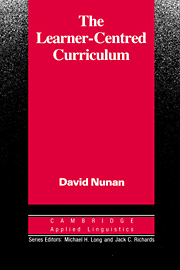Book contents
- Frontmatter
- Contents
- Series Editors' Preface
- Preface
- 1 Introduction
- 2 Curriculum Processes
- 3 Learner-Centred Curriculum Development
- 4 Pre-Course Planning Procedures
- 5 Planning Content
- 6 Methodology
- 7 Resources for a Learner-Centred Curriculum
- 8 Assessment and Evaluation
- 9 Evaluation and Professional Development
- 10 The Teacher as Curriculum Developer
- References
- Appendix
- Subject Index
- Author Index
10 - The Teacher as Curriculum Developer
Published online by Cambridge University Press: 05 April 2013
- Frontmatter
- Contents
- Series Editors' Preface
- Preface
- 1 Introduction
- 2 Curriculum Processes
- 3 Learner-Centred Curriculum Development
- 4 Pre-Course Planning Procedures
- 5 Planning Content
- 6 Methodology
- 7 Resources for a Learner-Centred Curriculum
- 8 Assessment and Evaluation
- 9 Evaluation and Professional Development
- 10 The Teacher as Curriculum Developer
- References
- Appendix
- Subject Index
- Author Index
Summary
Introduction
The central theme of this book has been that, in a learner-centred educational system, it is the teacher who is the principal agent of curriculum development. In this final chapter we shall look at how teachers respond when cast in this role.
Data for this chapter were derived from a national study of teachers as curriculum developers within the Australian Adult Migrant Education Program. Within the AMEP, a centralised curriculum model had given way to a learner-centred one. The initial question prompting the study was as follows:
What happens when a national language programme abandons its centralised curriculum for a localised learner-centred model?
It quickly became apparent that the most tangible result of the abandonment of a centralised curriculum was fragmentation and perceived lack of continuity in the curriculum. The national study was established to investigate and take steps to remedy perceived shortcomings in the curriculum area. The study thus came to focus on the following questions:
What are the causes of curriculum discontinuity?
What can be done to alleviate these?
Who should be involved in the process of remedying perceived shortcomings in the curriculum?
The Teacher as Curriculum Developer – A National Study
Background
The study was based on the Australian Adult Migrant Education Program which is one of the largest single-language programmes in the world with annual enrolments in excess of 120,000. In 1980 the AMEP abandoned its centralised curriculum in favour of a localised model which, it was hoped, would facilitate the development of more appropriate courses for the Program's extremely diverse client group.
- Type
- Chapter
- Information
- The Learner-Centred CurriculumA Study in Second Language Teaching, pp. 151 - 180Publisher: Cambridge University PressPrint publication year: 1988



